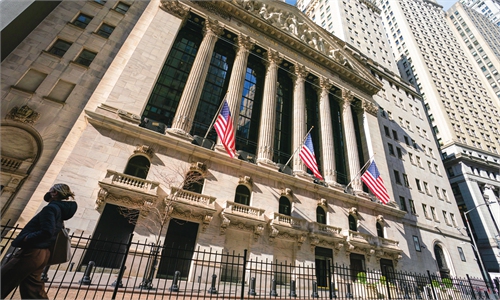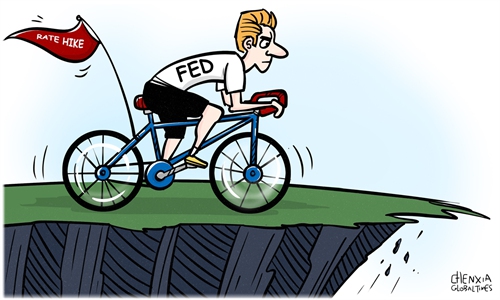
A customer stands outside of a shuttered Silicon Valley Bank (SVB) headquarters on March 10, 2023 in Santa Clara, California. Photo: VCG
Fears of further bank collapses after the failures of Silicon Valley Bank and Signature Bank are seemingly haunting the market again as US regional banks at the heart of the liquidity crunch storm continue to struggle to stay afloat. It proves one thing that the Biden administration can hardly find quick fix to crisis incurred by long-time problems.
First Republic Bank, which saw its stocks close down about 50 percent on Tuesday, is exploring an asset sale of up to $100 billion as part of a broader rescue plan, according to Bloomberg News.
The development came after the US bank surprised the market on Monday by disclosing its deposit fell 40.8 percent, or more than $100 billion, to $104.5 billion in the first quarter, despite a temporary $30 billion lifeline from some large banks last month.
It goes without saying that the latest earnings report by First Republic heightened concerns about deposit outflows, asset-liability mismatch, and credit crunch in regional banks. After the Biden administration assured the market last month the US banking system is safe, the sharp deposit exodus clearly says the opposite, or at least the crisis of confidence in regional banks is not over.
In addition to First Republic, quite a number of regional banks have also reported deposit outflows in their latest earnings report for the first quarter. Last week, Moody's Investor Services downgraded 11 regional banks, according to media reports.
It should be noted that by various standards, First Republic's business operation is not very problematic, and its non-performing loan ratio is not at a high level. But the plunge in its share price suggests that investors' worries could be enough to push it back into huge trouble, triggering a new round of bank run.
Fundamentally speaking, after the failures of Silicon Valley Bank and Signature Bank, market fears of the liquidity crunch have not been fully repaired. And the fragile market confidence may push the US to the brink of another financial crisis. If the market panic over regional banks' liquidity was reignited, depositors would be again desperate to pull their money out of the banks.
And the scenario that more banks may go into trouble could drive the US economy into a predicament. This is because once banks had problems, they would not be able to offer support to companies in various sectors, which may fail down and lead to unemployment and sluggish consumption, prompting an economic recession. In fact, the latest news that US retail giant Bed Bath & Beyond on Sunday filed for Chapter 11 bankruptcy protection after failing to raise enough money to keep the company alive may just serve as the latest sign in such development.
The Biden administration had already made various efforts to stabilize market sentiment, which may have seen some effects, but temporary bailout plan has become increasingly ineffective and no one knows what will come next and whether the country could narrowly avoid a crisis. Now US President Joe Biden has formally announced his bid for reelection, but economic problems, if broke out, could be a huge drag on his campaign.
Crises are never created in a single day. The root causes of the potential economic crisis have actually been derived from some of the US long-term policies, including the monetary one. To maintain the false prosperity, the Federal Reserve adopted unlimited money printing, leading to soaring inflation. Then, the Fed's tightening monetary policy aimed at taming in inflation created new problems for the financial markets, risking a new round of economic crisis.
Meanwhile, the US' "decoupling" push from China may also play a role. China is a major supplier of goods to the US. If the Biden administration cannot lower tariffs on Chinese imports, "decoupling" from China will have big impacts on the low- and medium-end consumption in the US. Many countries could be affected as their entire economic structure and market are related to the US and have to adjust based on the "decoupling" policy. The global industrial chains are forced to adjust under the US push, which will eventually lead to liquidity problems in the supply chains. Therefore, during the process of the US linking economic issues with geopolitics and China policy, low- and middle-end consumption in the US could be seriously subdued.



